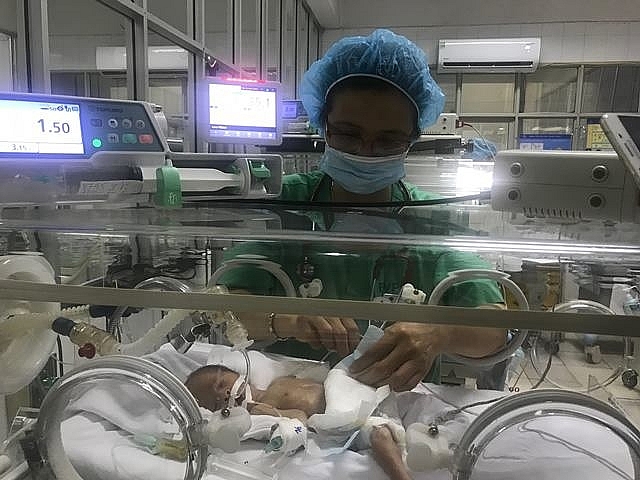‘Second mothers’ save thousands of infants
 |
| Dr Nguyen Thi Thu Hoa cares for a premature baby at the Centre for Neonatal Care, part of the National Hospital of Obstetrics and Gynecology in Hanoi. - Photo nhandan.com.vn |
The boy, named Tran Nam, was treated at the hospital’s Centre for Neonatal Care after being born at 24 weeks. His parents were nearly 50 years old at the time of his birth.
He was born from in vitro fertilisation (IVF). He weighed just 500gr and his body parts were not completely developed, Dr Hoa told the Nong Thon Ngay Nay (Countryside Today) newspaper.
Hoa said the boy faced heart attacks and various serious illnesses from his premature birth, but doctors and nurses at the centre never gave up on saving him.
“In three months in intensive care, Nam was saved many times,” Hoa said. “He was discharged but we still worried for his health and his brain development. I am so happy to hear the good news from his family.”
The doctors and nurses are always happy when they get good news from the families of babies who were treated at the centre. They care for the children as their own and come to feel like a second set of parents.
Every day, doctors and nurses deal with premature and underweight babies who fall ill after being born.
According to the centre’s director, Dr Le Minh Trac, they receive 25,000-26,000 newborn babies. 4,000 are premature, underweight babies, 30 per cent of whom are under 1,500gr.
Many of these children were born at 24 to 26 weeks weighing between 500 and 700gr, he said.
Since 2010, the hospital has saved the lives of five babies who weighed 500gr at birth.
“I have worked here in newborn care for 22 years,” said Hoa. “It is wonderful to save premature babies weighing only 500-700gr.”
Underweight babies are put into an incubator and provided with positive-pressure ventilation, antibiotic treatment and phototherapy.
Strict procedures have to be followed, and each baby is given an ID number. Their condition decides how long they will stay at the centre. When they are at their weakest, they occupy an intensive care unit in the middle of the centre and are moved to adjacent rooms as they get better. Those placed in rooms closest to the centre’s exit are those about to go home.
Working closely with the newborns, the doctors and medical staff are intimately aware of the progress each one makes. They know each baby’s name, weight and family situation by heart, and recognise parents without having to see identification.
They all feel a tug in their hearts upon seeing these tiny figures, only a few days old and already surrounded by all types of cords and medical equipment, Dr Hoa said.
“Looking at them, it occurs to me that I am not just saving a child, but the hope of their families.”
Hoa related the seven major factors in caring for premature children, which include resuscitation, body temperature, respiration, hypoglycemia, nutrition, jaundice and enteritis.
The babies are constantly at risk of suffocating and getting hypothermia, infections and hemorrhages.
“Our hopes rise and drop with their weight and the oxygen indicators in their blood,” said nurse Nguyễn Thị Thu Trang.
“Timely treatment is crucial,” Trang said. “We don’t dare leave them out of sight for one second for fear of unfortunate incidents.”
“The children do not have the strength to cry out or make any major movements so the doctors not only look at the indicators on the machines but must constantly observe each grimace and small move to react quickly.”
“But it is a joy to watch them grow from premature babies that fit in the palms of my hands into beautiful, healthy children.”
The gifts that make doctors and nurses happy were the tiny eyes and smiles of the little angels, Trang said.
“We are so joyful when the babies can eat more than a millilitre of milk and excrete themselves.”
Every year, thousands of children are saved and go home in good health. Many families take their children to the hospital for yearly follow-up visits with the doctors.
“Each child is a joy in the heart of the doctors,” Hoa said. “Looking at the children who have been saved by us is the motivation to help us overcome the hardships and difficulties to save more lives.”
What the stars mean:
★ Poor ★ ★ Promising ★★★ Good ★★★★ Very good ★★★★★ Exceptional
Related Contents
Latest News
More News
- Protect what’s next: towards a future free from meningococcal group B disease (December 05, 2025 | 18:00)
- New ILO report offers policy recommendations for disability inclusion (December 04, 2025 | 15:18)
- Maternal job loss may affect children’s mental health, research shows (December 03, 2025 | 19:11)
- Women lead Vietnam’s shift to climate-resilient agriculture (December 03, 2025 | 19:10)
- Experts highlight unpaid care work as key barrier to gender equality (December 03, 2025 | 15:15)
- Opportunities and inequalities for women workers in Vietnam's garment industry (December 03, 2025 | 09:00)
- Vietjet flights carry love to devastated central region (November 28, 2025 | 11:35)
- New initiative to boost the fight against domestic violence (November 26, 2025 | 10:00)
- South Korea funds IOM relief for Vietnam’s typhoon-affected communities (November 24, 2025 | 15:33)
- AI and human-centred values set to shape the future of HR in Vietnam (November 21, 2025 | 18:04)

 Tag:
Tag:

















 Mobile Version
Mobile Version